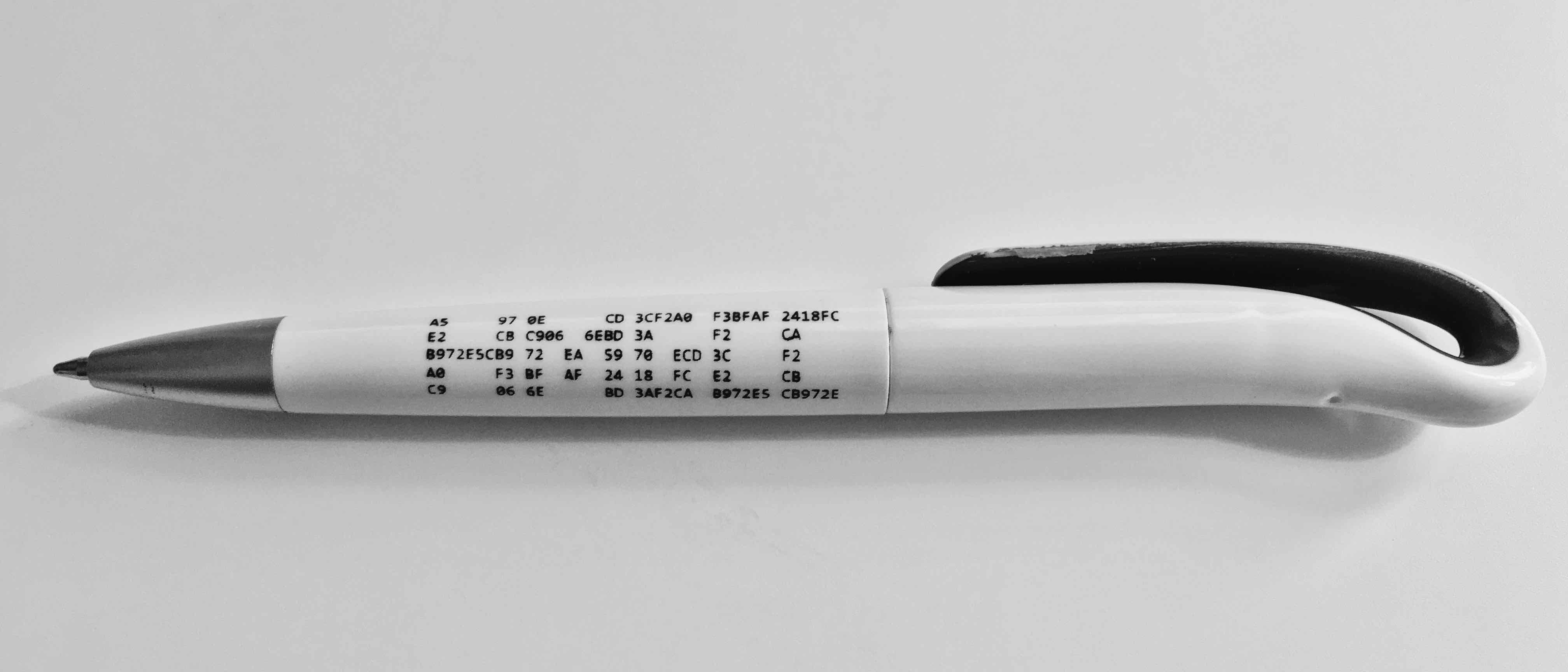On Friday 11 August, HMGCC hosted the third out of five Face to Face events at the UK Defence Academy which is part of the 2017 Cyber Security Challenge UK masterclass qualifiers.
As host, HMGCC found the perfect environment to host a cyber security challenge and it was within this environment that they managed to hide one of their challenges in plain sight; a swag pen with HEX characters forming the letters HMGCC. It took the better of an hour before officials had to announce that everybody should “search their tables for any foreign objects”. A pen had for each team member been placed on our desks overnight, and I personally (as well as everyone else) did not think any more of this until the hint was announced. Below is a photo of the pen.

Pen HEX values digitalised
The obvious first step was to digitalise the HEX values found on the pen. However, some of the letters and digits caused issues as it was hard to distinguish S and 5 from each other. Therefore, first attempt failed and my team mate Eed gave a helping hand by checking for typo’s. Below is the final digital printout which is the basis of the challenge.
A5 97 0E CD 3CF2A0 F3BFAF 2418FC
E2 CB C906 6EBD 3A F2 CA
B972E5CB9 72 EA 59 70 ECD 3C F2
A0 F3 BF AF 24 18 FC E2 CB
C9 06 6E BD 3AF2CA B972E5 CB972E
With the HEX values captured, an initial conversion from HEX to ASCII was attempted using asecuritysite’s ASCII, Hex, Base-64 and Binary convertor. The results did not return 100% positive. However, the ASCII conversion gave away that the HEX values had been duplicated. At this moment, we got stuck and the time presure with other challenges due made us decide on utilising one of our free hints (hint disclosed in next section).
We did not have enough time to program anything during the challenge, thus the above website was used for analysis and conversion from HEX to ASCII. After the challenge, I decided that it would be interesting to script a solution and below code snippet shows how it could have been done using Python 2.7.
import binascii
hex = """ A5 97 0E CD 3CF2A0 F3BFAF 2418FC
E2 CB C906 6EBD 3A F2 CA
B972E5CB9 72 EA 59 70 ECD 3C F2
A0 F3 BF AF 24 18 FC E2 CB
C9 06 6E BD 3AF2CA B972E5 CB972E"""
hex = hex.translate(None, ' \n') #remove whitespace and newlines
print "Hex in ASCII\t",binascii.unhexlify(hex)
print "Count of bytes:",len(hex)/2, "bytes\n"
Python printout:
Hex in ASCII ���<��$����n�:�ʹr�˗.���<��$����n�:�ʹr�˗.
Count of bytes: 56 bytes
As mentioned before, the data duplication can be seen above by the repeating pattern of �ʹr�˗. in the middle and at the end of the HEX string. Effectively, the HEX stream can be cut in half or in its entirety. I leave it thus expect the result to come out twice when solved. Double the points, right? :)
Being under time pressure, we decided to leave two team mates working on other challenges, while me and Eed continued with help from the new hint.
Hint (spoilers and solution below)
As time progressed, we decided on utilising one of our free hints. It turned out, that we had already passed the first two hints prepared by the officials and we could therefore only get the last one. Mixed feelings, as it meant we had gotten really close, but if we couldn’t make use of the hint then time would have been wasted.
You are waiting for the hint, aren’t you?
Ok, so the hint is simply SMS
We did not know what to make of it, but raced to Google and started searching for SMS decoders and quickly discovered an Online SMS PDU Decoder. This site takes HEX values as input and convert data-streams into readable SMS text messages. Win?! Sadly not, a dead end and we returned to research further into SMS protocols.
At this moment, we still didn’t really know if we had decoded the HEX values correctly, but the duplicated values pointed in the right direction. Thankfully, it didn’t take long till we discovered GSM 03.38, a 7-bit GSM alphabet which could have been used to generate the hidden message.
From the online conversion on asecuritysite, each HEX value had already been converted to binary and we simply copied this manually into a text editor and began deciphering by cutting the bit stream into chunks of 7.
Below is a snippet of the manual process which was used to positively produce the correct answer. HURRAY!
Binary HEX ASCII
1010010 52 R
1100101 65 e
1100001 61 a
1101100 6C l
.
.
.
.
1110100 74 t
1110101 75 u
1110010 72 r
1100101 65 e
Fully automated using Python 2.7 and the bitstring module.
import bitstring
binaryString = bin(int(hex,16))
bytes = []
b = bitstring.BitArray(binaryString)
for byte in b.cut(7): #cut bytestream into chunks of 7-bytes
print chr(int(byte.bin,2)) #conv datatypes and print bin>int>char
Python printout:
R
e
a
l
i
s
e
y
o
u
r
c
y
b
e
r
f
u
t
u
r
e
.
.
.
.
.
.
.
R
e
a
l
i
s
e
y
o
u
r
c
y
b
e
r
f
u
t
u
r
e
.
.
.
.
.
.
.
Browsing to HMGCC’s website, have a look at the top left logo and picture with a similar quote. Picture linked below.
Thanks to HMGCC for the challenge, now to the second pen that was handed out by the end of the Face to Face challenge :)

